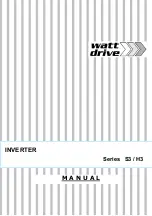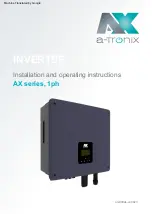
PVI 3000/4000/5000/5300
Installation
and Operation Manual
47
Inverter Specifications
PVI 3000
PVI 4000
PVI 5000
PVI 5300
DC Input Specifications
Continuous Power @240 VAC
3050W
4100W
5150W
5575W
@208 VAC
2840W
3580W
4520W
4840W
Recommended Max. PV
@240 VAC
3600W
4900W
6200W
6700W
Array Power, STC Rating
@208 VAC
3400W
4300W
5400W
5800W
MPPT Voltage Range
200V-550 VDC
200V-550 VDC
200V-550 VDC
200V-550 VDC
Maximum Input Voltage
600 VDC
600 VDC
600 VDC
600 VDC
Strike Voltage
235 VDC
235 VDC
235 VDC
235 VDC
Maximum Input Current
16 A
20 A
25 A
25 A
Maximum Short Circuit Current
24 A
24 A
30 A
30 A
Fused Inputs
3
4
4
4
AC Output Specifications
Continuous Power @240 VAC
2900W
3900W
4900W
5300W
@208 VAC
2700W
3400W
4300W
4600W
Voltage Range @240 VAC
211-264 VAC
211-264 VAC
211-264 VAC
211-264 VAC
@208 VAC
183-228 VAC
183-228 VAC
183-228 VAC
183-228 VAC
Frequency 60Hz
Range: 59.3-60.5Hz
60Hz
Range: 59.3-
60.5Hz
60Hz
Range: 59.3-60.5Hz
60Hz
Range: 59.3-60.5Hz
Continuous Current (Max.)
13.1 A
16.55 A
20.8 A
22.5 A
Output Current Protection
20 A
25 A
30 A
30 A
Max. Backfeed Current to PV
0 A
0 A
0 A
0 A
Power Factor
Utility, >99%
Utility, >99% Utility,
>99% Utility,
>99%
THD <3%
<3%
<3%
<3%
Efficiency Peak @240 VAC
96.7
96.7
96.6
96.4
@208 VAC
96.4
96.5
96.4
96.2
CEC Efficiency @240 VAC
96
96
96
96
@208 VAC
95.5
95.5
96.0
95.5
General
Enclosure
Rainproof, NEMA 3R
Housing Material
Painted aluminum
Ambient Temperature Range
-25
C to +55
C
Cooling
Convection
Convection and fan assist
Weight
50.7 lb (23 kg)
50.7 lb (23 kg)
61.7 lb (28 kg)
61.7 lb (28 kg)
Size (L x W x H)
28 4/5 in x 17 3/4 in x 6 3/4 in (732mm x 454mm x 175mm) 28 4/5 in x 17 3/4 in x 8 1/4 in (732mm x 454mm x 210mm)
Wire Sizes
12 to 6 AWG input and output connections
Standards UL1741/IEEE1547,
IEEE1547.1, ANSI62.41.2, FCC part 15 B
Warranty
10 years standard
This maximum recommended power is a nominal figure based on an array with a relatively optimal tilt angle
and orientation (south) as well as other average conditions. Array over-sizing is used because PV modules
rarely run at their STC ratings. However, if the array is oversized too much clipping of maximum power by
the inverter can occur in optimal conditions. PV module STC conditions are rarely achieved because the
cells are usually at a higher temperature when full 1-sun is available, or when cells are at STC temperatures,
the sun's intensity is often times less than 1-sun. Because STC conditions are rarely achieved, array over-
sizing of 10-20% achieves best overall economic trade-off with inverter and array costs. The maximum
recommended power to be connected to the inverter is very much dependent on average weather conditions,
economic optimization, tilt and of the array and orientation (for example south, or rotating array). For arrays
that are flat or nearly flat in northern location where the sun's rays are never close to being perpendicular to
the array, the array can be oversized more than these recommendations. For locations that are hazy or
cloudy for most of the year, also more array over-sizing may be appropriate. For arrays aiming at the sun or
rotating arrays that face the sun all the time, less array over-sizing may be a good choice.









































